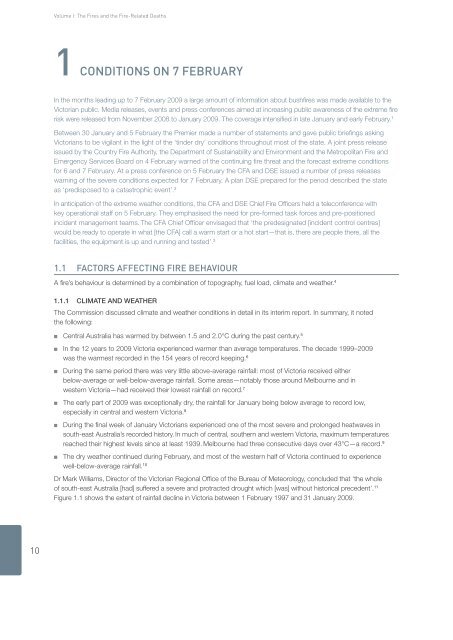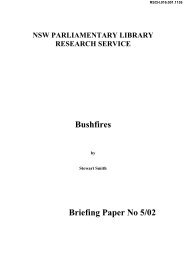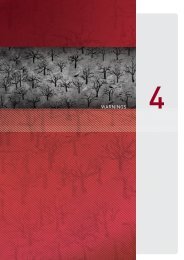1 CONDITIONS ON 7 FEBRUARY - 2009 Victorian Bushfires Royal ...
1 CONDITIONS ON 7 FEBRUARY - 2009 Victorian Bushfires Royal ...
1 CONDITIONS ON 7 FEBRUARY - 2009 Victorian Bushfires Royal ...
Create successful ePaper yourself
Turn your PDF publications into a flip-book with our unique Google optimized e-Paper software.
Volume I: The Fires and the Fire-Related Deaths<br />
1 Conditions on 7 february<br />
In the months leading up to 7 February <strong>2009</strong> a large amount of information about bushfires was made available to the<br />
<strong>Victorian</strong> public. Media releases, events and press conferences aimed at increasing public awareness of the extreme fire<br />
risk were released from November 2008 to January <strong>2009</strong>. The coverage intensified in late January and early February. 1<br />
Between 30 January and 5 February the Premier made a number of statements and gave public briefings asking<br />
<strong>Victorian</strong>s to be vigilant in the light of the ‘tinder dry’ conditions throughout most of the state. A joint press release<br />
issued by the Country Fire Authority, the Department of Sustainability and Environment and the Metropolitan Fire and<br />
Emergency Services Board on 4 February warned of the continuing fire threat and the forecast extreme conditions<br />
for 6 and 7 February. At a press conference on 5 February the CFA and DSE issued a number of press releases<br />
warning of the severe conditions expected for 7 February. A plan DSE prepared for the period described the state<br />
as ‘predisposed to a catastrophic event’. 2<br />
In anticipation of the extreme weather conditions, the CFA and DSE Chief Fire Officers held a teleconference with<br />
key operational staff on 5 February. They emphasised the need for pre-formed task forces and pre-positioned<br />
incident management teams. The CFA Chief Officer envisaged that ‘the predesignated [incident control centres]<br />
would be ready to operate in what [the CFA] call a warm start or a hot start—that is, there are people there, all the<br />
facilities, the equipment is up and running and tested’. 3<br />
1.1 Factors affecting fire behaviour<br />
A fire’s behaviour is determined by a combination of topography, fuel load, climate and weather. 4<br />
1.1.1<br />
Climate and weather<br />
The Commission discussed climate and weather conditions in detail in its interim report. In summary, it noted<br />
the following:<br />
■■<br />
■■<br />
■■<br />
■■<br />
■■<br />
■■<br />
Central Australia has warmed by between 1.5 and 2.0°C during the past century.<br />
In the 12 years to <strong>2009</strong> Victoria experienced warmer than average temperatures. The decade 1999–<strong>2009</strong><br />
was the warmest recorded in the 154 years of record keeping. 6<br />
During the same period there was very little above-average rainfall: most of Victoria received either<br />
below-average or well-below-average rainfall. Some areas—notably those around Melbourne and in<br />
western Victoria—had received their lowest rainfall on record. 7<br />
The early part of <strong>2009</strong> was exceptionally dry, the rainfall for January being below average to record low,<br />
especially in central and western Victoria. 8<br />
During the final week of January <strong>Victorian</strong>s experienced one of the most severe and prolonged heatwaves in<br />
south-east Australia’s recorded history. In much of central, southern and western Victoria, maximum temperatures<br />
reached their highest levels since at least 1939. Melbourne had three consecutive days over 43°C—a record. 9<br />
The dry weather continued during February, and most of the western half of Victoria continued to experience<br />
well-below-average rainfall. 10<br />
Dr Mark Williams, Director of the <strong>Victorian</strong> Regional Office of the Bureau of Meteorology, concluded that ‘the whole<br />
of south-east Australia [had] suffered a severe and protracted drought which [was] without historical precedent’. 11<br />
Figure 1.1 shows the extent of rainfall decline in Victoria between 1 February 1997 and 31 January <strong>2009</strong>.<br />
5<br />
10
















